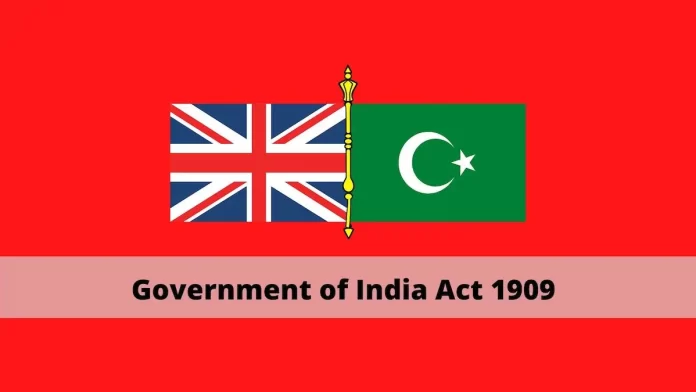Introduction
The Government of India Act 1909 assumes great significance in the legal and constitutional history of India because, for the first time, it recognized and legalized the concept of separate electorates in India.
Under this system, the reservation was first granted to Muslims and later extended to other backward communities in the proportion to their population.
The separate or communal electorates aimed to give an effective political representation to backward communities hitherto unrepresented in British Indian polity.
In the current scheme reservation system when a constituency is declared reserved, all voters of that constituency vote for the candidates who come from a specific community.
However, under a communal or separate electorate system, only the voters from that specific community vote or elect their representative-cum-leader from the same community for which the seat has been declared reserved.
The Government of India Act 1909 provided for this separate electorate system.
The Act is also known as Morley-Minto Reforms as Lord Morley was the then Secretary of State for India and Lord Minto was the then Viceroy of India.
Government of India Act 1909: Key Features
Some distinguishing features of the Government of India Act 1909 are as follows-
Increase in the size of the Legislative Councils
The Government of India Act 1909 considerably increased the size of the legislative councils, both at the central and provincial levels.
For instance, the number of members in the Central Legislative Council was raised from 16 to 60. But the number of members in the provincial legislative councils was not uniform.
It also the number of elected members therein. However, most of the elected members were still elected indirectly.
Non-Official Majority in Provincial Legislatures
The Government of India Act 1909 retained an official majority in the Central Legislative Council but allowed the provincial legislative councils to have a non-official majority.
According to Bipin Chandra, of the sixty-eight members of the central Imperial Legislative Council, thirty-six were officials, and five were nominated non-officials.
Further out of twenty-seven elected members, six were elected by big landlords and two by British capitalists, he adds.
More Powers to Legislative Councils
The Government of India Act 1909 Act enlarged the deliberative functions of the legislative councils at both levels.
For instance, the Act permitted members to move resolutions, ask supplementary questions, etc.
The Act also allowed members to vote on separate budget items.
Indians in the Executive Council of Viceroy
The Government of India Act 1909 provided (for the first time) for the association of Indians with the executive councils of the Viceroy and Governors.
Satyendra Prasad Sinha became the first Indian to join the Viceroy’s Executive Council. He was appointed as a law member.
Communal Representation for Muslims
The Government of India Act 1909 Act introduced a system of communal representation for Muslims by accepting the concept of a “separate electorate”.
Under this, the Muslim members were to be elected only by Muslim voters of the constituency reserved for Muslims.
Hindu upper castes alleged that by doing so the Act “legalized communalism” and Lord Minto came to be known as the Father of Communal Electorate.
It also provided for the separate representation of presidency corporations, chambers of commerce, universities, and zamindars.
Criticism
The Government of India Act 1909 invited mixed reactions from Indians. While the Muslims, in general, welcomed it for ensuring them secured representations, the Hindu upper-caste-dominated Congress expressed disappointment.
One common criticism of the 1909 Act was that even though it increased the power of legislative councils, at least in theory, they still enjoyed no real power in practice and continue to remain mere advisory bodies.
Second, the Government of India Act 1909 had no object of introducing even an elementary sort of democratic or parliamentary system in India.
Lord Morley, the secretary of state for India openly declared in the British Parliament that “if it could be said that this chapter of reforms led directly or necessarily up to the establishment of a Parliamentary system in India, I, for one, would have nothing at all to do with it”.
Thus, one can say that the undemocratic, foreign and exploitative character of British rule remained unchanged.
According to Bipin Chandra, the real purpose of the Government of India Act 1909 or Morley-Minto Reforms was to divide the nationalist ranks and to check the growing unity among Indians by encouraging the growth of communalism by legalizing separate electorates for Muslims.
